Overview
The article “7 Strategies for Successful Labor Union Elections” presents effective approaches that unions can adopt to enhance their electoral processes and increase participation. It outlines critical strategies, such as:
- Leveraging technology for secure online voting
- Ensuring compliance with NLRB regulations
- Fostering member education and engagement
These strategies are all aimed at promoting higher turnout and strengthening the union’s collective voice.
Furthermore, by integrating technology, unions can streamline the voting process, making it more accessible and secure for members. Compliance with NLRB regulations is essential to maintain the integrity of the electoral process, ensuring that all actions taken are within legal frameworks. In addition, fostering member education and engagement not only empowers members but also reinforces the importance of their participation in union activities.
Ultimately, these strategies serve to create a robust framework for successful labor union elections, encouraging active involvement and solidifying the union’s influence. Union leadership is encouraged to adopt these approaches to enhance their electoral outcomes and amplify their collective voice.
Introduction
Navigating the complexities of labor union elections demands a multifaceted approach that adheres to regulatory standards while actively engaging members. As unions encounter increasing scrutiny and challenges, the opportunity to enhance participation and ensure fair outcomes through strategic planning becomes paramount.
Union leaders must ask themselves: How can they effectively implement best practices to not only meet legal requirements but also foster a vibrant electoral culture that empowers their members?
This inquiry is crucial for establishing a robust electoral framework that resonates with the membership.
Votem: Secure Online Voting for Labor Union Elections
Votem’s CastIron platform stands as a robust online voting solution tailored for labor organizations, specifically designed to facilitate labor union elections while ensuring strict adherence to vital regulations such as the National Labor Relations Board (NLRB) and the Labor-Management Reporting and Disclosure Act (LMRDA). This commitment to compliance not only enhances the integrity of the voting process but also cultivates trust among union participants. With its , members are empowered to cast their votes conveniently from any location, potentially tripling participation rates on launch day, as highlighted in recent studies.
The company’s dedication to accessibility is underscored by testimonials from satisfied clients, including the New Mexico State Republican Party, which praised the software’s effectiveness during their elections. Furthermore, the platform’s advanced encryption and comprehensive audit trail features guarantee transparency and security, thereby reinforcing trust within the community. With a proven track record of overseeing more than 13 million votes, including significant events like the National Radio Hall of Fame, where it successfully managed the collection of 299,000 votes, Votem exemplifies the efficacy of online voting systems in the context of labor union elections. This paves the way for modernized electoral processes that prioritize accessibility and participant engagement.
Moreover, Votem offers hybrid voting alternatives, allowing organizations to choose the most suitable voting methods for their members. This flexibility not only meets diverse needs but also enhances overall engagement in the electoral process.
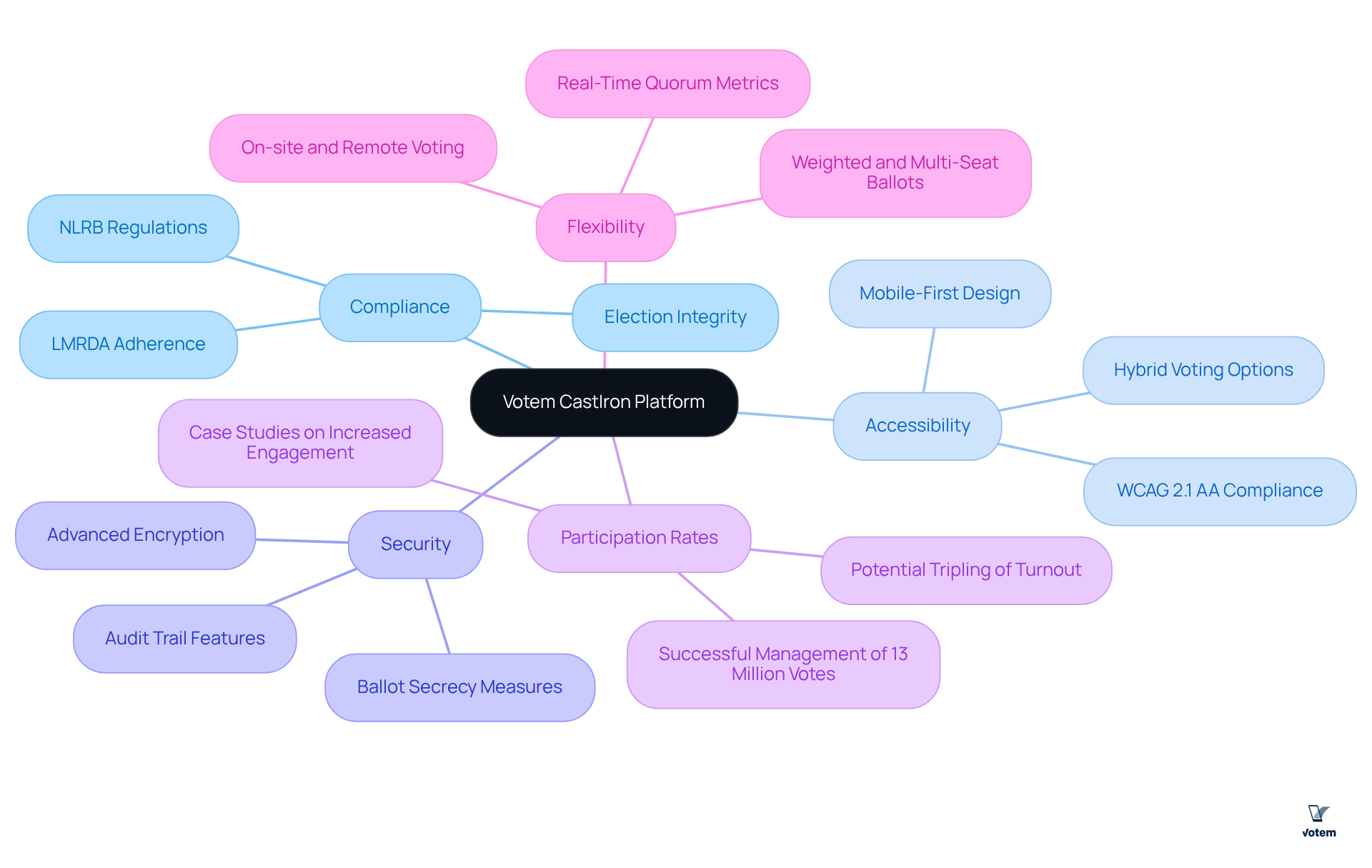
National Labor Relations Board (NLRB): Navigating Union Election Regulations
The National Labor Relations Board (NLRB) plays a crucial role in supervising labor union elections, ensuring adherence to federal laws and fairness throughout the voting process. It is imperative that union leaders thoroughly comprehend [NLRB regulations](https://votem.com/5-strategies-for-effective-election-compliance-in-unions), including the processes for submitting petitions and the rights of employees to organize. A solid understanding of these regulations is essential to reduce legal challenges and secure the acknowledgment and certification of votes by the NLRB.
Recent updates, such as the reinstatement of practices that allow worker organizations to obstruct voting under certain conditions, further emphasize the necessity for these groups to navigate these regulations efficiently. In 2025, the NLRB is anticipated to oversee a substantial number of union votes, indicating a rising trend where unions are securing a greater share of contests than in recent history. Notably, there has been a reported 30% year-over-year increase in NLRB petitions from 2023 to 2024. This evolving landscape highlights the significance of with NLRB processes to ensure successful voting outcomes.
As Michelle ‘Micky’ Devitt observed, the NLRB’s regional offices are now expected to arrange votes for ‘the earliest date practicable,’ underscoring the accelerated nature of the current voting process. However, labor leaders must remain vigilant regarding potential legal challenges that may arise from these new regulations, particularly in light of recent court rulings affecting the validity of the NLRB’s voting rules.
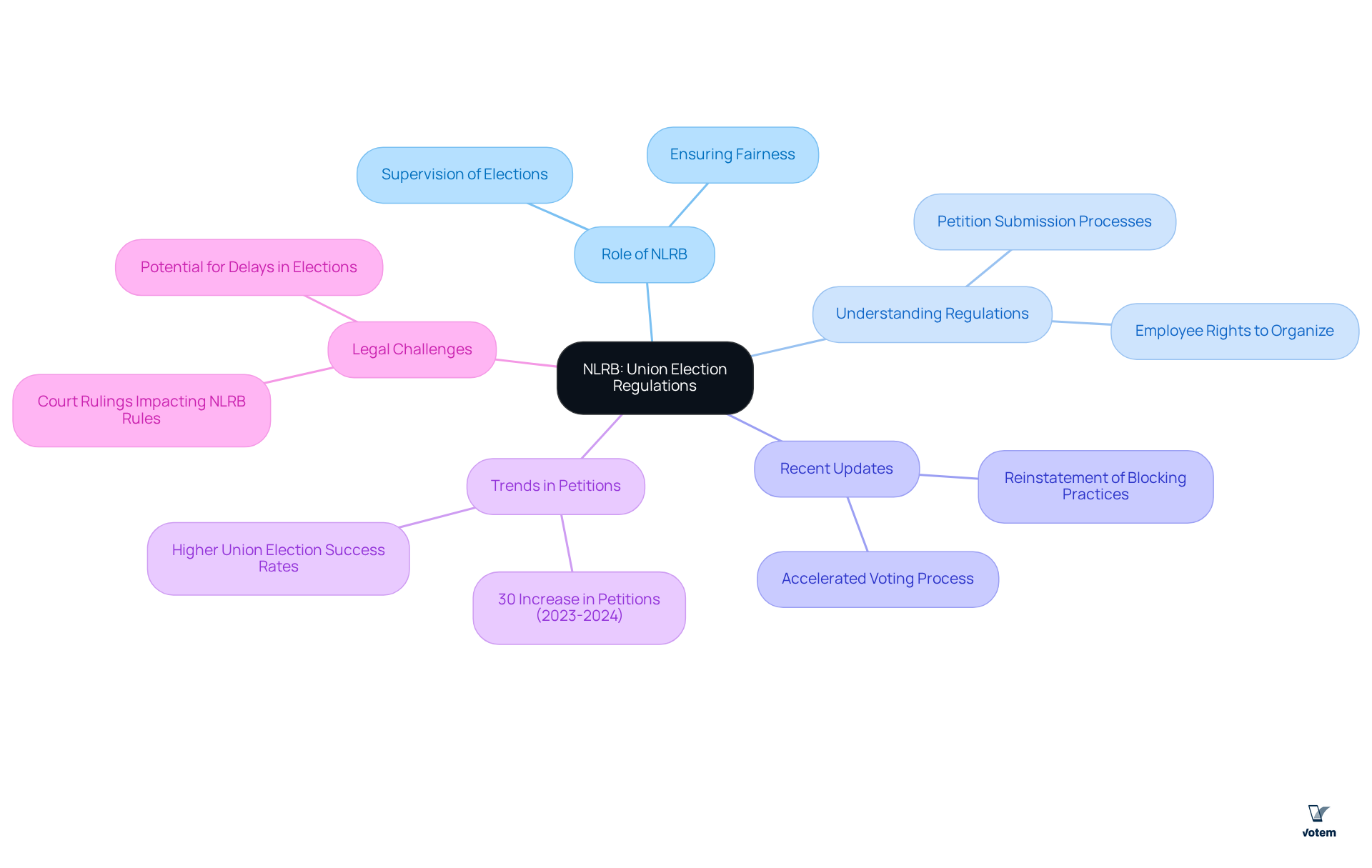
Communication Strategies: Engaging Union Members for Higher Turnout
To boost voter turnout, unions must adopt that include regular updates, reminders, and educational resources about labor union elections. Engaging participants through various channels—such as emails, social media, and in-person meetings—ensures that all individuals are well-informed and motivated to participate in labor union elections. Customizing messages to address specific issues can significantly enhance participant engagement. For instance, unions that have effectively utilized targeted messaging have witnessed participation rates increase by up to three times on election day. Furthermore, maintaining consistent communication fosters trust and encourages members to take an active role in labor union elections.
The company’s innovative online voting solutions have demonstrated improvements in accessibility and security. As Linda McCulloch observed, “Implementing the new, modern system which allowed greater access for all qualified voters, from military voters to those with disabilities, was my greatest achievement in office.” This highlights the need for unions to prioritize accessibility in their communications. Additionally, the organization successfully managed the receipt of 299,000 votes for the National Radio Hall of Fame, showcasing a significant increase in voter turnout.
By leveraging these strategies, including the use of platforms like Votem’s CastIron, unions can create a more informed electorate for labor union elections. This ultimately leads to higher turnout and a stronger collective voice. Now is the time for union leadership to take decisive action and implement these effective communication strategies.
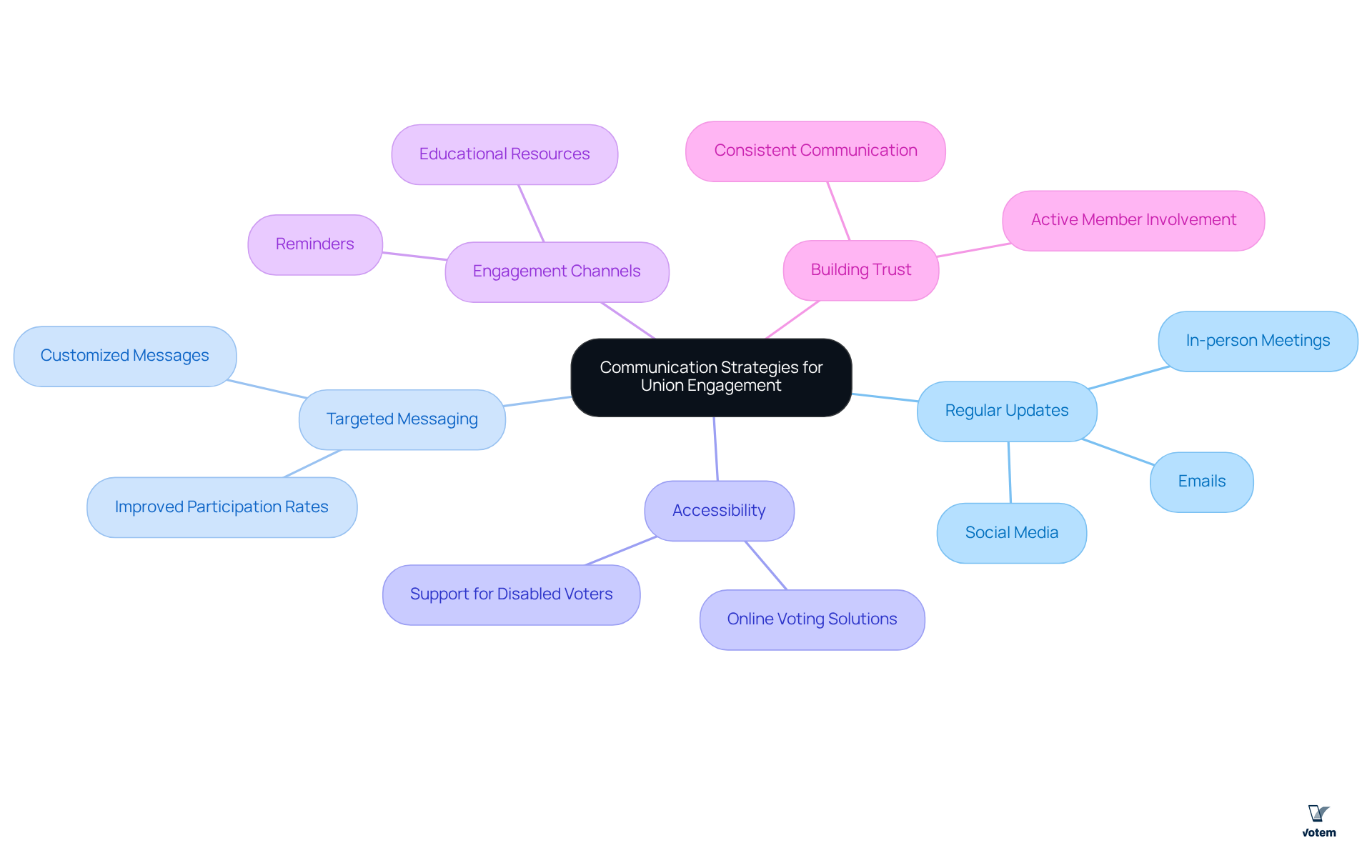
Member Education: Informing Workers About Their Rights and the Election Process
Union leaders must prioritize the education of their constituents by providing comprehensive information about their and the complexities of labor union elections. By utilizing workshops, informational pamphlets, and online resources, they can effectively inform individuals about the significance of their vote and the steps required for active participation. Furthermore, by ensuring that all individuals are well-versed in their rights, unions can cultivate a culture of engagement and empowerment, ultimately enhancing participation in labor union elections.
Effective workshops have demonstrated that knowledgeable participants are more inclined to engage in labor union elections, resulting in higher turnout and a more powerful collective voice. Educational resources should also focus on voting rights, ensuring members understand the deadlines for mail-in ballots and early voting, as well as how to check their registration status. This proactive strategy not only strengthens the organization’s stance but also reinforces the significance of collective action in advocating for workers’ rights. In addition, it is crucial for union leadership to recognize the challenges faced by their constituents and address these with clarity and authority.
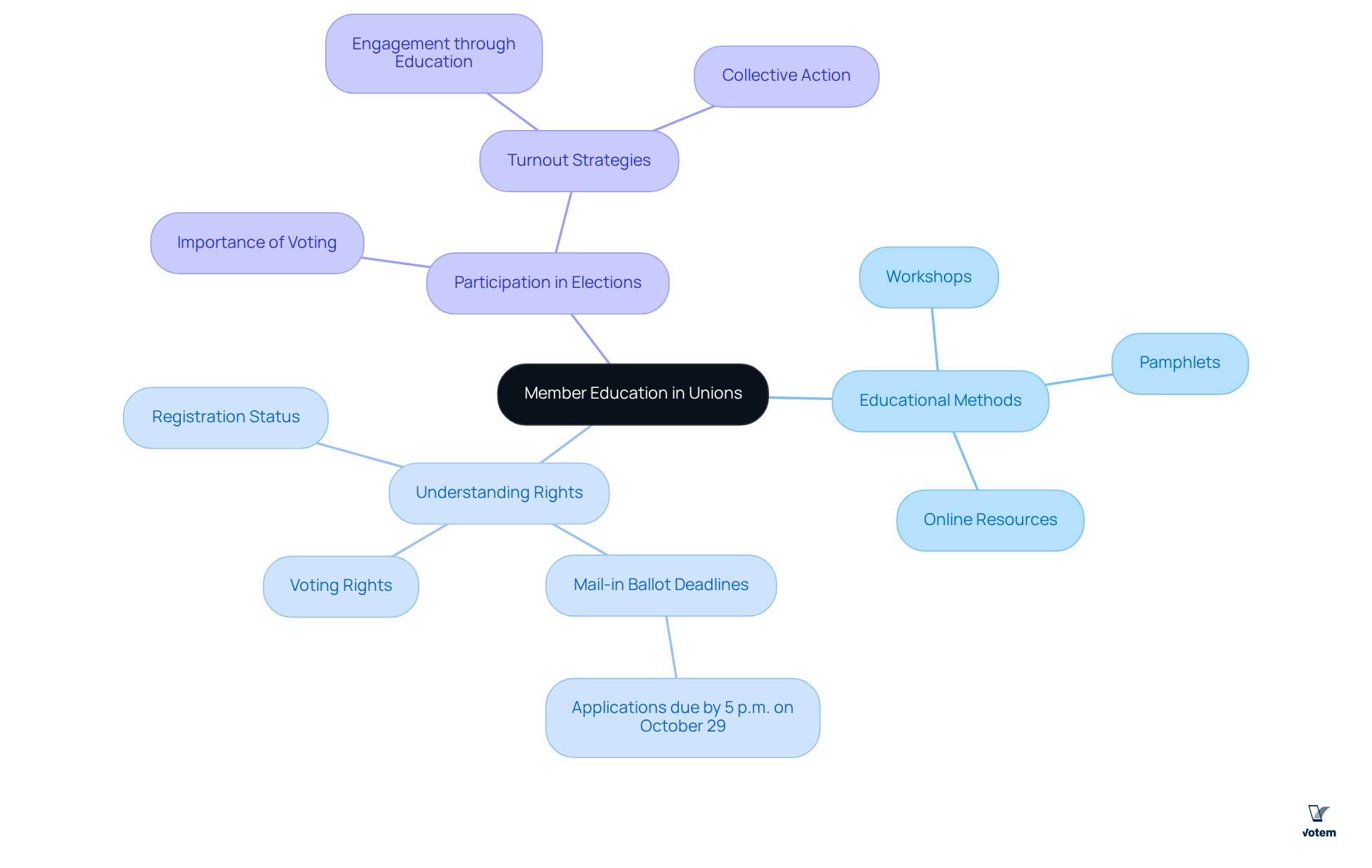
Election Strategy Development: Planning for Success in Union Elections
Meticulous planning and strategic development are crucial for successful labor union elections. Union leaders must begin by clearly outlining their goals and identifying that resonate with their constituents. A comprehensive timeline for the labor union elections is essential, as it ensures that all necessary steps are completed promptly, ultimately influencing the outcome.
Involving collective participants during the planning stage is crucial. This involvement fosters a sense of ownership and commitment to the labor union elections, which significantly boosts turnout and engagement. Such a collaborative approach not only empowers members but also amplifies the union’s collective voice. As Linda McCulloch stated, “Implementing Votem’s new, modern system which allowed greater access for all qualified voters from military voters to voters with disabilities was my greatest accomplishment in office.”
Furthermore, analyzing previous voting results from labor union elections can yield valuable insights. By assessing which strategies proved effective and identifying areas for improvement, leaders can refine their approaches for future labor union elections. The successful management of 299,000 votes for the National Radio Hall of Fame, as highlighted in their testimonial, exemplifies the potential for increased participation through modern voting systems. This reflective practice enables organizations to adapt and evolve, ensuring that their strategies for labor union elections remain relevant and effective in a changing labor landscape.
Integrating these best practices into the strategy development process, alongside Votem’s proven track record of enhancing voter engagement and security, will equip organizations for success. This preparation allows them to navigate the complexities of labor union elections with confidence and clarity.
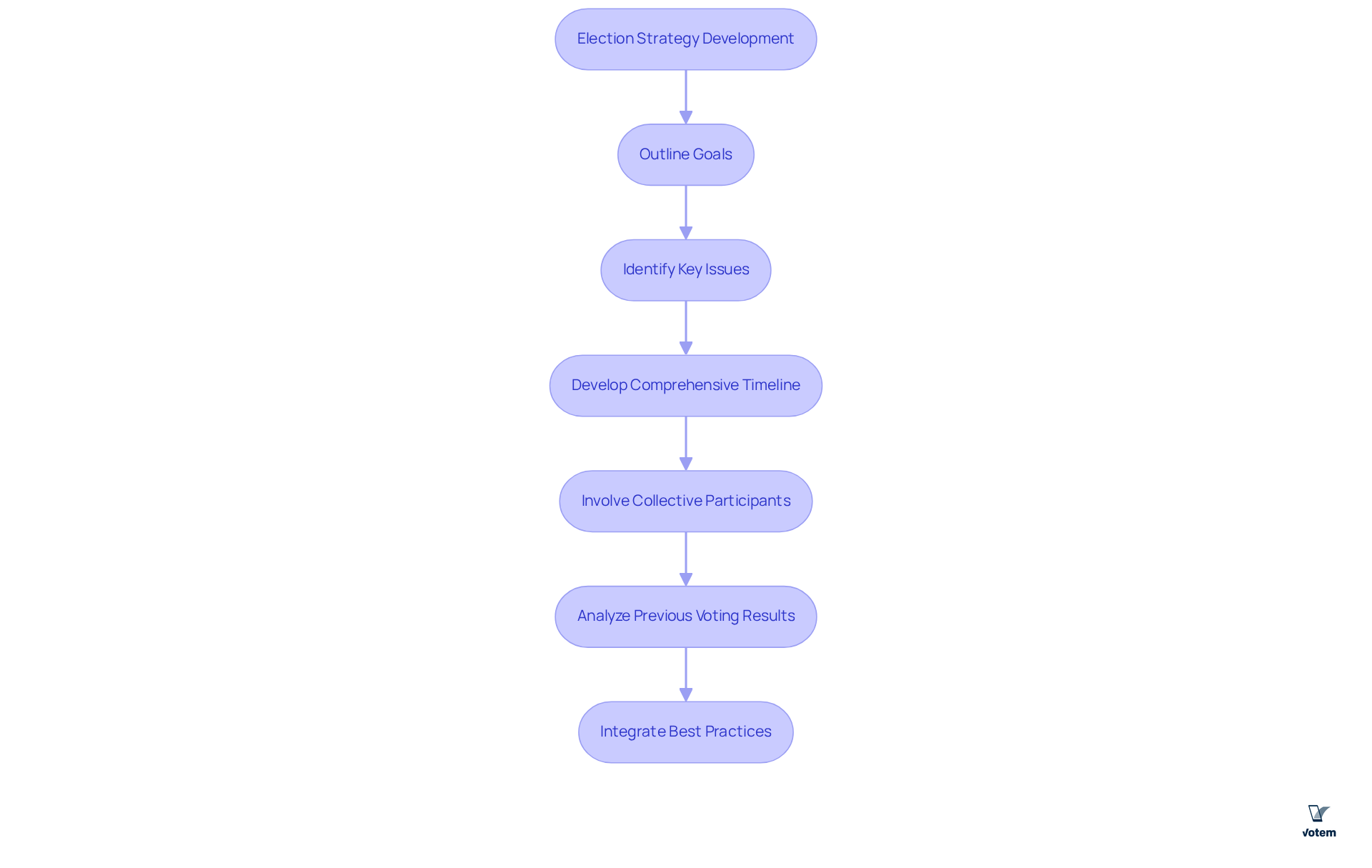
Challenge Management: Addressing Issues During Union Elections
Labor union elections often face significant challenges, including disputes over eligibility, campaign conduct, and incidents of voter intimidation. To effectively manage these issues, union leaders must implement that address potential disputes as they arise. Forming a voting committee can provide essential oversight and ensure transparency throughout the process. This committee should also establish a system for individuals to report concerns, fostering an environment of open communication.
Proactive strategies, including conflict resolution techniques, are vital for mitigating issues and maintaining trust in labor union elections. For instance, data indicates that voter intimidation incidents can significantly undermine participation; thus, addressing these concerns swiftly is crucial. Expert opinions suggest that a structured method for dispute resolution not only enhances the integrity of labor union elections but also strengthens member trust in the union’s governance.
Furthermore, employing CastIron’s innovative online voting solutions can further assist these initiatives by offering secure online voting that improves accessibility, security, and transparency in democratic processes. Testimonials from past clients underscore the success of the platform:
- “Implementing the new, modern system which allowed greater access for all qualified voters, from military voters to voters with disabilities, was my greatest accomplishment in office.”
- “Votem assisted in delivering 123,000 votes, more than double the turnout of the previous contest in 2015 and the highest number of votes since the voting process started 30 years ago! Thank you!”
By leveraging technology and proven success, labor organizations can effectively address challenges and foster a more inclusive electoral environment.
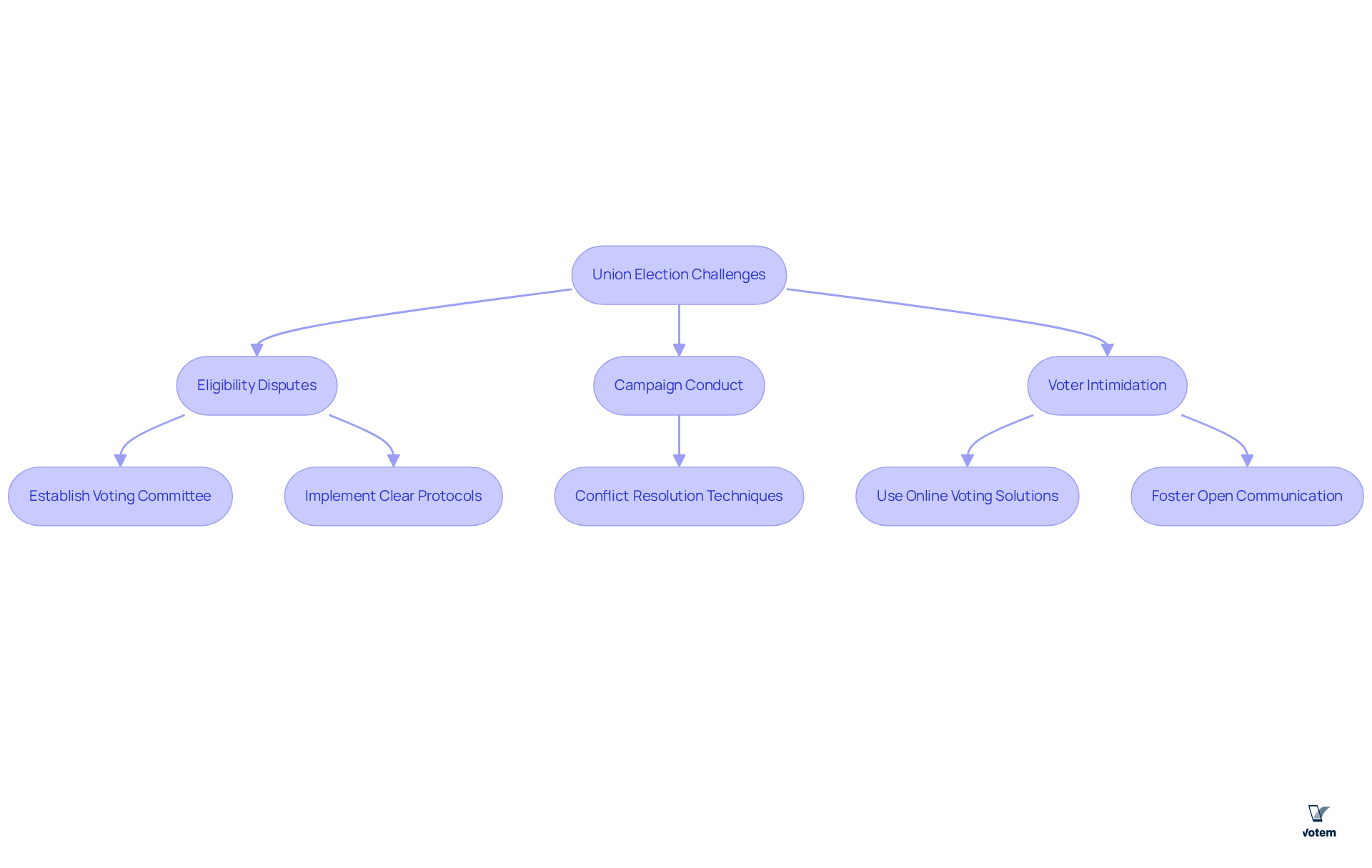
Post-Election Certification: Ensuring a Smooth Transition for New Unions
Following a successful vote, understanding the NLRB certification process is vital for labor union elections. This process requires the submission of voting results and adherence to all legal obligations, which is essential for legitimizing the newly elected representatives. Furthermore, labor organizations must remain vigilant regarding potential delays in the certification process stemming from objections related to labor union elections. These objections can be utilized by employers to challenge the results of the labor union elections, thereby prolonging the certification timeline.
Effective communication about the certification’s significance fosters transparency and trust, thereby strengthening the organization’s authority. Involving individuals during this transition phase is crucial; it not only sustains support for the new leadership but also encourages active participation in forthcoming collective activities. Union leaders should leverage and maintain consistent outreach methods to keep participants informed and engaged.
By prioritizing these steps, organizations can ensure a seamless transition that solidifies their position and enhances participant confidence in their leadership. This is particularly important in an environment where anti-association tactics may attempt to undermine their efforts.
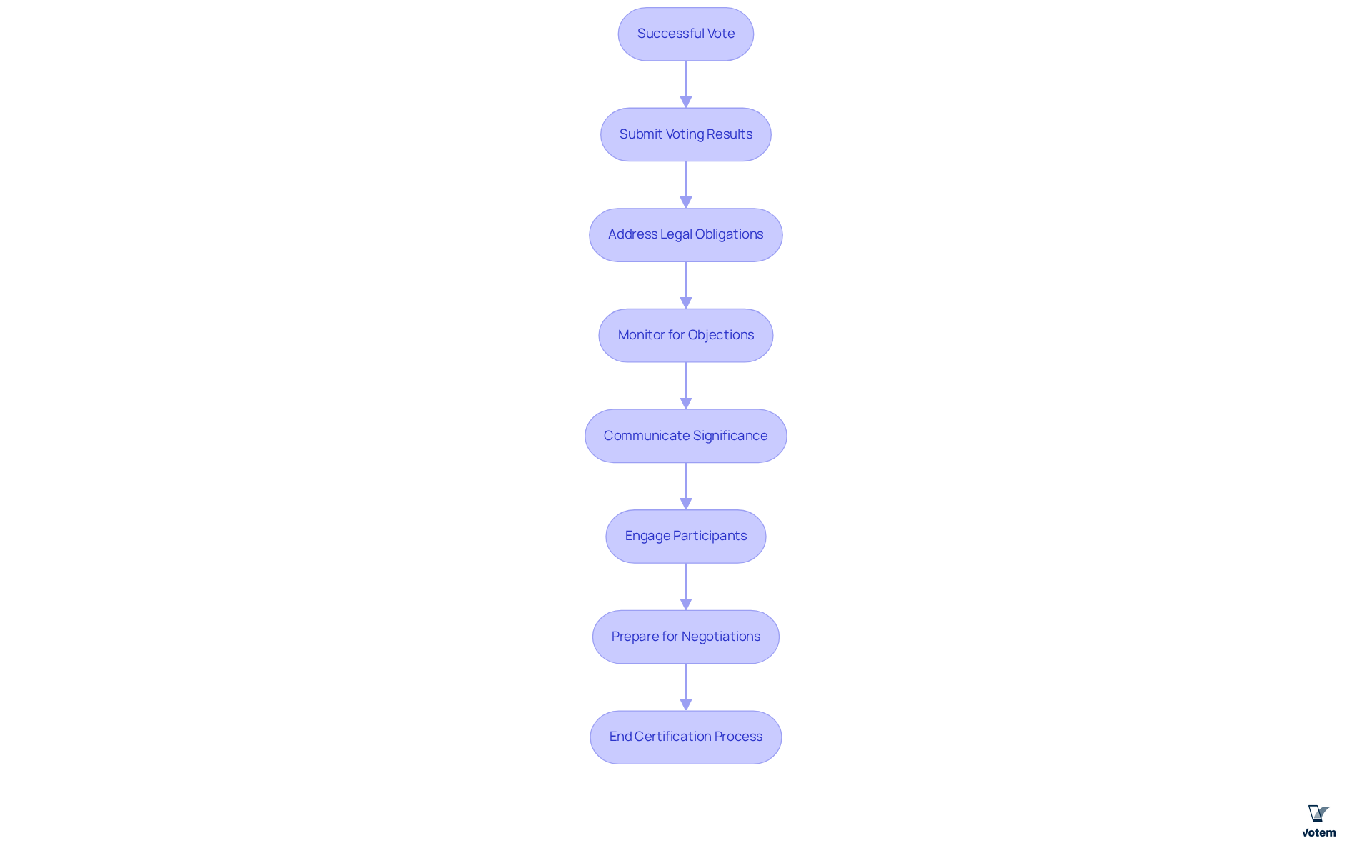
Technology Integration: Enhancing Labor Union Elections with Digital Tools
The integration of significantly enhances the electoral process. Online voting platforms, mobile applications, and digital communication channels provide members with easier access to participate in polls, thereby greatly increasing participation rates. For example, a mobile-first user experience can elevate voter turnout by as much as three times on launch day, showcasing the effectiveness of these tools. As a comprehensive elections partner, the organization delivers extensive end-to-end election services, ensuring that all stakeholders can have confidence in the electoral outcomes.
By harnessing technology, unions can gather real-time data on voter engagement and preferences, facilitating more informed decision-making and strategic adjustments. Successful implementations of the CastIron platform, which has managed over 13 million votes, illustrate that secure online voting not only streamlines the process but also fosters trust among members. Client testimonials underscore the effectiveness of Votem’s services, notably the New Mexico State Republican Party’s satisfaction with their software performance.
Furthermore, expert insights suggest that hybrid approaches, which merge traditional and digital methods, yield the most robust results, ensuring inclusivity and adherence to regulations. As labor organizations adapt to a younger audience, the utilization of digital resources becomes essential for maintaining relevance and enhancing participation in labor union elections. However, it is imperative to tackle challenges such as preserving ballot secrecy and guaranteeing accurate vote casting within electronic systems to uphold the integrity of the electoral process.
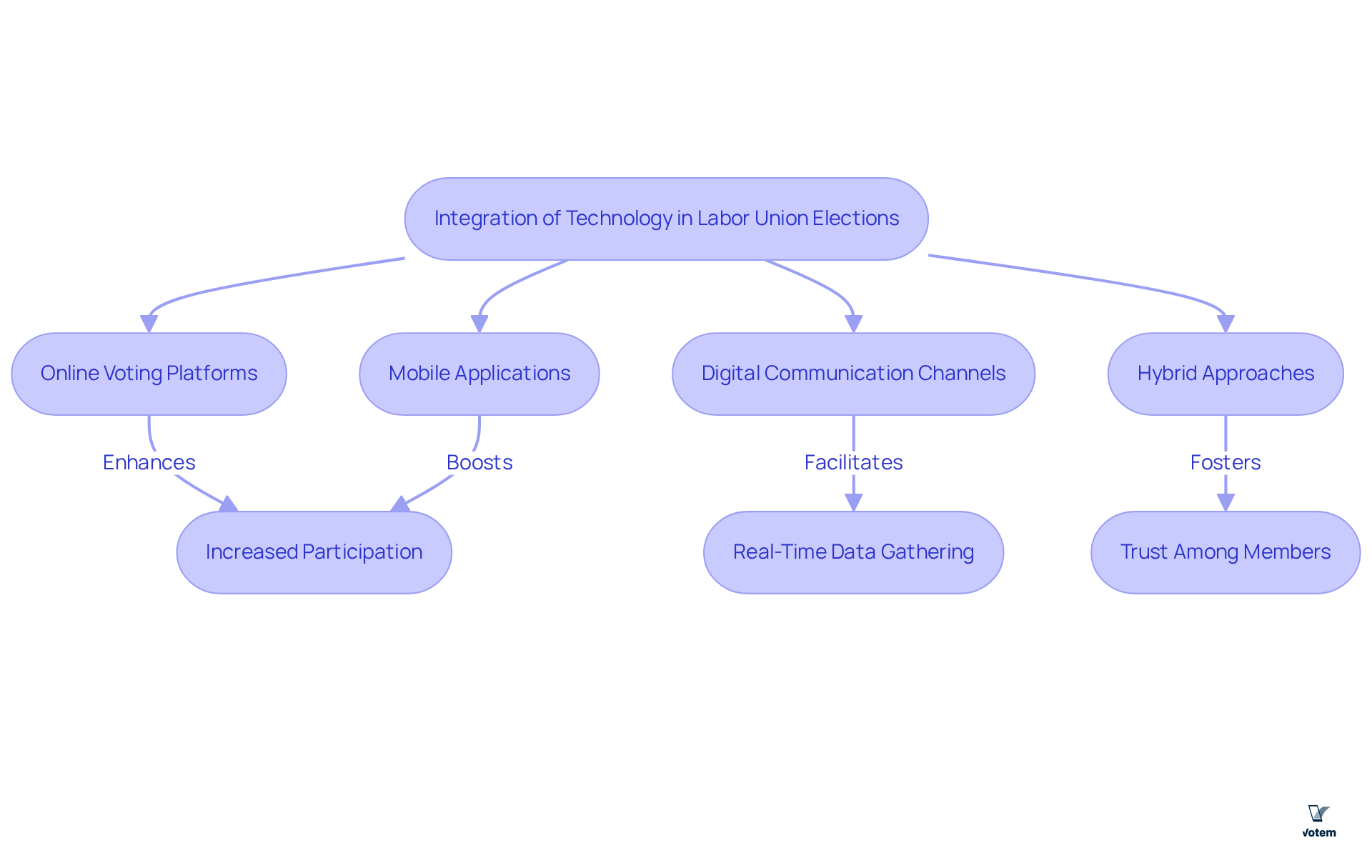
Data Analysis: Learning from Previous Labor Union Elections
Examining previous labor union elections is essential for revealing patterns in voter participation, choices, and the success of different tactics. Unions must systematically collect and assess information from past labor union elections to identify successful strategies and areas needing enhancement. For instance, the National Labor Relations Board reported a significant success rate of 77% in private sector collective bargaining votes. This revitalization suggests that labor organizations can learn from successful campaigns surrounding labor union elections to enhance member engagement and boost participation.
Furthermore, by utilizing these insights—including the features of innovative online voting solutions that improve accessibility and security while boosting voter participation—organizations can refine their future voting strategies. Votem’s platform has already demonstrated success in , as evidenced by testimonials from satisfied clients who noted significant improvements in participation and accessibility for all voters, including those with disabilities. This strategic integration of technology ensures that collective votes resonate with members and drive higher turnout.
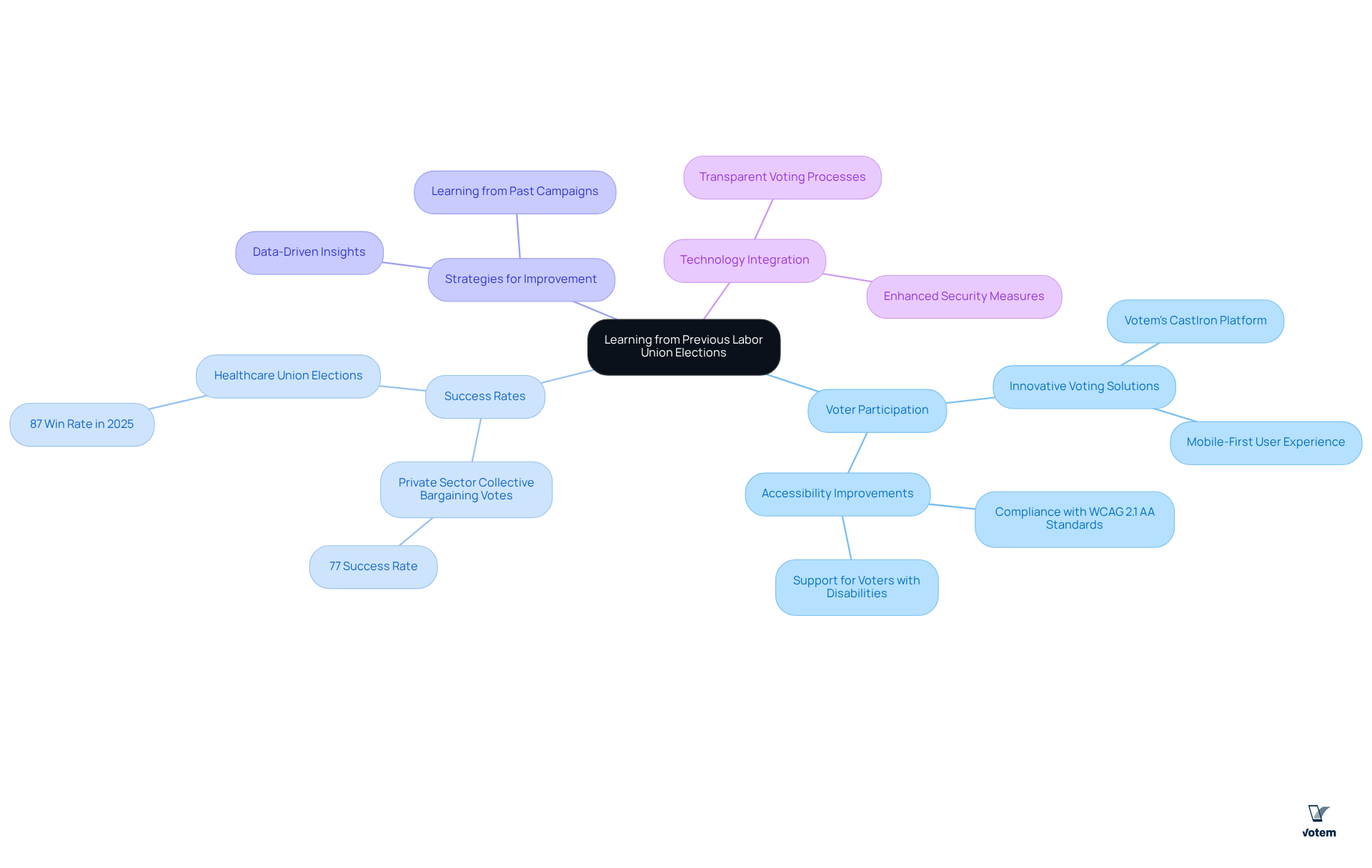
Coalition Building: Strengthening Union Election Efforts Through Partnerships
Coalition formation serves as a crucial tactic for labor organizations aiming to enhance their voting initiatives. By collaborating with community organizations, advocacy groups, and fellow unions, labor organizations can effectively pool resources, share expertise, and broaden their outreach. Such collaborations have shown a significant increase in voter engagement and mobilization, leading to higher turnout and more effective voting outcomes.
For example, the Labor Strong 2025 Coalition, which represents over 320,000 workers in New York City, illustrates how uniting various labor groups can amplify their collective voice and influence in local elections. Labor Strong’s financial commitment is evident, as they invested over $2 million to support more than 50 candidates in the 2021 and 2023 City Council races, demonstrating the effectiveness of coalition efforts. Furthermore, the Protect Utah Workers coalition’s successful signature collection effort engaged over 5,000 workers and volunteers, exceeding 320,000 signatures to support a referendum against restrictive labor legislation. This underscores the power of in driving electoral change.
Expert opinions reinforce that these strategic alliances not only enhance the electoral process but also foster a sense of solidarity among workers. As Henry A. Garrido, Executive Director of District Council 37, states, “Solidarity is our strength— as individual unions and as a Coalition— and there has never been a more critical time to come together and fight for candidates who will put our workers and working families first.” This statement highlights the labor movement’s significant impact in shaping policies that benefit all members.
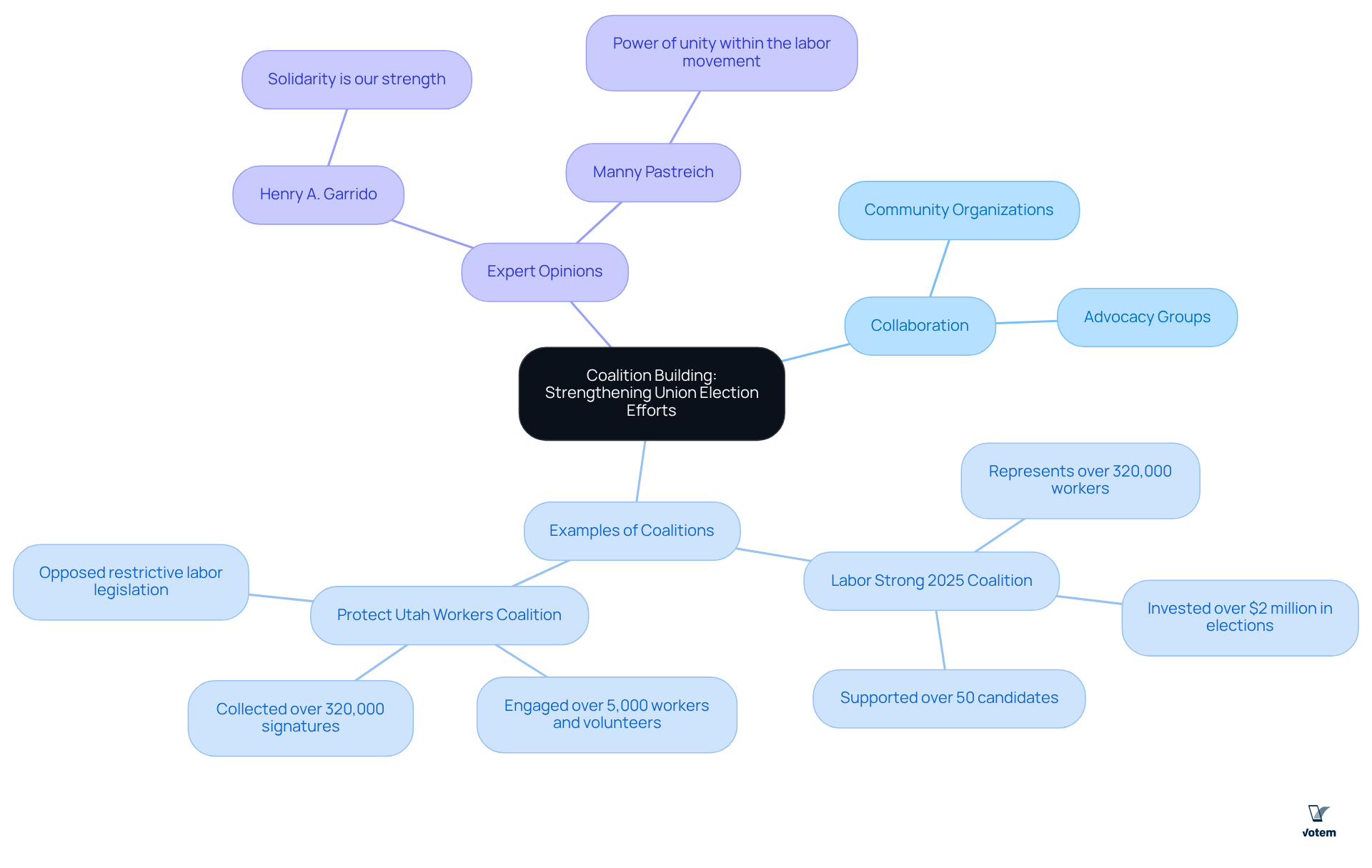
Conclusion
The successful execution of labor union elections relies on a multifaceted approach that incorporates strategic planning, member education, and the integration of technology. By understanding the critical components that drive participation and engagement, unions can elevate the electoral process and ensure that every voice is heard. The insights shared throughout this article highlight the importance of adapting to current regulations, employing effective communication strategies, and utilizing innovative voting solutions like Votem’s CastIron platform to enhance voter turnout.
Key strategies discussed include:
- The necessity of navigating NLRB regulations
- Fostering robust communication with union members
- Prioritizing education about voting rights and processes
Furthermore, the significance of coalition building and data analysis cannot be overstated, as these elements contribute to a more informed electorate and a united front in advocating for workers’ rights. By leveraging these strategies, labor organizations can not only improve participation rates but also strengthen their overall influence within the labor landscape.
As the landscape of labor union elections continues to evolve, it is crucial for union leaders to remain proactive and adaptive. Embracing technology, fostering collaboration, and ensuring that members are well-informed will pave the way for successful elections in 2025 and beyond. Taking decisive action now will empower unions to navigate challenges effectively and amplify their collective voice, ultimately leading to a more equitable and engaged workforce.
Frequently Asked Questions
What is Votem’s CastIron platform designed for?
Votem’s CastIron platform is designed as a secure online voting solution specifically for labor organizations, facilitating labor union elections while ensuring compliance with regulations such as the National Labor Relations Board (NLRB) and the Labor-Management Reporting and Disclosure Act (LMRDA).
How does Votem enhance voter participation?
Votem’s mobile-first design allows union members to cast their votes conveniently from any location, which can potentially triple participation rates on election day, as indicated by recent studies.
What security measures does Votem implement?
Votem incorporates advanced encryption and comprehensive audit trail features to guarantee transparency and security in the voting process, thereby reinforcing trust within the community.
How many votes has Votem successfully managed?
Votem has overseen more than 13 million votes, including significant events like the National Radio Hall of Fame, where it managed the collection of 299,000 votes.
What flexibility does Votem offer in voting methods?
Votem provides hybrid voting alternatives, allowing organizations to choose the most suitable voting methods for their members, which enhances overall engagement in the electoral process.
What role does the National Labor Relations Board (NLRB) play in union elections?
The NLRB supervises labor union elections to ensure adherence to federal laws and fairness throughout the voting process, making it essential for union leaders to understand NLRB regulations.
What recent trends have been observed in NLRB petitions?
There has been a reported 30% year-over-year increase in NLRB petitions from 2023 to 2024, indicating a rising trend where unions are securing a greater share of contests than in recent history.
What communication strategies can unions use to increase voter turnout?
Unions can adopt effective communication strategies such as regular updates, reminders, and educational resources, utilizing various channels like emails, social media, and in-person meetings to engage members and motivate participation.
How can targeted messaging affect voter participation?
Customizing messages to address specific issues can significantly enhance participant engagement, with some unions experiencing participation rates increase by up to three times on election day through targeted messaging.
Why is accessibility important in union communications?
Prioritizing accessibility in communications ensures that all qualified voters, including military voters and those with disabilities, can participate in labor union elections, ultimately leading to higher turnout and a stronger collective voice.
List of Sources
- Votem: Secure Online Voting for Labor Union Elections
- Labor union election outcomes U.S. 2023| Statista (https://statista.com/statistics/1374939/labor-union-election-outcome)
- Cleveland Blockchain Company Votem Abruptly ‘Restructures’ with Major Layoffs (https://clevescene.com/news/cleveland-blockchain-company-votem-abruptly-closes-all-employees-fired-29207551)
- Unions | Online Voting with Votem® (https://votem.com/unions)
- Electing Union Officers Using Remote Electronic Voting Systems (https://dol.gov/agencies/olms/compliance-assistance/tips/remote-electronic-voting-systems)
- National Labor Relations Board (NLRB): Navigating Union Election Regulations
- Federal Court Invalidates NLRB’s New Election Rule | CDF Labor Law LLP (https://cdflaborlaw.com/blog/federal-court-invalidates-nlrbs-new-election-rule)
- NLRB Issues New Election Rules Which Make It Easier for Unions To Organize (https://natlawreview.com/article/nlrb-issues-new-election-rules-which-make-it-easier-unions-to-organize?amp)
- New Rule Restores Faster, Simpler Election Procedures at NLRB | Willig, Williams & Davidson (https://wwdlaw.com/new-rule-restores-faster-simpler-election-procedures-at-nlrb)
- NLRB Reinstates Weapons for Unions in Attempting to Organize Non-Union Workplaces | CDF Labor Law LLP (https://callaborlaw.com/blog/nlrb-reinstates-weapons-for-unions-in-attempting-to-organize-non-union-workplaces)
- Communication Strategies: Engaging Union Members for Higher Turnout
- IAFF hosts 2025 Communications and Political Training Academies – IAFF (https://iaff.org/news/iaff-hosts-2025-communications-and-political-training-academies)
- The Business of Union Elections: A Comprehensive Guide (https://numberanalytics.com/blog/business-guide-to-union-elections)
- electionbuddy.com (https://electionbuddy.com/blog/2024/10/18/developing-labor-union-election-strategies)
- CESI NEWS | 3rd #WEP training on communication and social media (https://cesi.org/posts/3rd-wep-training-on-communication-and-social-media)
- Modernizing Labor Communications: A Necessary Evolution for Labor (https://ulanetwork.com/blog/modernizing-labor-communications-a-necessary-evolution-for-labor)
- Member Education: Informing Workers About Their Rights and the Election Process
- How the New Administration Could Impact U.S. Labor Unions – UnionTrack® (https://uniontrack.com/blog/how-the-new-administration-could-impact-u-s-labor-unions)
- Largest Public Sector Labor Unions Unite to Get Out the Vote in Battleground States (https://afscme.org/press/releases/2024/largest-public-sector-labor-unions-unite-to-get-out-the-vote-in-battleground-states)
- Your Voice, Your Vote (https://massteacher.org/current-initiatives/election)
- pewresearch.org (https://pewresearch.org/short-reads/2024/10/17/key-facts-about-union-members-and-the-2024-election)
- Election Strategy Development: Planning for Success in Union Elections
- electionbuddy.com (https://electionbuddy.com/blog/2024/10/18/developing-labor-union-election-strategies)
- The Business of Union Elections: A Comprehensive Guide (https://numberanalytics.com/blog/business-guide-to-union-elections)
- 16 million workers were unionized in 2024: Millions more want to join unions but couldn’t (https://epi.org/publication/millions-of-workers-millions-of-workers-want-to-join-unions-but-couldnt)
- Union Election Campaigns » National Labor Relations Advocates (https://nlradvocates.com/union-election-campaigns)
- Challenge Management: Addressing Issues During Union Elections
- Shorthanded: Labor Board Faces Challenges In Handling Influx of Cases (https://natlawreview.com/article/shorthanded-labor-board-faces-challenges-handling-influx-cases)
- Labor Board Sees Major Uptick in Activity During First Half of Fiscal Year: 3 Takeaways for Employers (https://fisherphillips.com/en/news-insights/labor-board-sees-major-uptick-in-activity.html)
- News & Commentary: June 12, 2025 ✦ OnLabor (https://onlabor.org/june-12-2025)
- Amazon labor organizers challenge union election loss, alleging employer coercion • NC Newsline (https://ncnewsline.com/2025/05/10/north-carolina-amazon-labor-organizers-challenge-union-election-loss)
- Post-Election Certification: Ensuring a Smooth Transition for New Unions
- Maintaining Union Support While Awaiting NLRB Certification (https://uniontrack.com/blog/nlrb-certification-2)
- After the Union Vote: Understanding the NLRB Certification Process (https://uniontrack.com/blog/nlrb-certification-process)
- Labor Board Returns to Pre-Trump Board Union Election Procedures – Jackson Lewis (https://jacksonlewis.com/insights/labor-board-returns-pre-trump-board-union-election-procedures)
- quarles.com (https://quarles.com/newsroom/publications/the-union-election-is-done-what-are-the-next-steps)
- Technology Integration: Enhancing Labor Union Elections with Digital Tools
- Advantages of online voting in union elections (https://kuorum.org/en/post/benefits-of-an-online-voting-tool-for-union-elections)
- Electing Union Officers Using Remote Electronic Voting Systems (https://dol.gov/agencies/olms/compliance-assistance/tips/remote-electronic-voting-systems)
- ulanetwork.com (https://ulanetwork.com/blog/how-unions-are-using-technology-to-organize-and-amplify-their-voice)
- uniontrack.com (https://uniontrack.com/blog/digital-tools-union-election)
- Data Analysis: Learning from Previous Labor Union Elections
- State of the U.S. Unions 2025 (https://ericdirnbach.medium.com/state-of-the-u-s-unions-2025-34ad1e2974da)
- Year-over-year petitions and elections are both down in the first quarter of 2025. (https://laborunionnews.substack.com/p/year-over-year-petitions-and-elections)
- The LRI RightNow Q2 2025 Petitions and Elections Review Is Here (https://news.lrionline.com/the-lri-rightnow-q2-2025-petitions-and-elections-review-is-here)
- US union organizing, and unions’ election win rate, is surging, NLRB says (https://reuters.com/legal/litigation/us-union-organizing-unions-election-win-rate-is-surging-nlrb-says-2024-07-17)
- Coalition Building: Strengthening Union Election Efforts Through Partnerships
- Labor Strong 2025 Coalition Representing 320,000+ New York City Workers Unites to Elect Pro-Union Majority in City Council (https://cwad1.org/press-releases/labor-strong-2025-coalition-representing-320000-new-york-city-workers)
- Labor and Community Coalition Building (https://apwu.org/labor-and-community-coalition-building)
- Labor, Congressional Leaders Demand House Vote to Restore Federal Workers’ Union Rights (https://afge.org/article/labor-congressional-leaders-demand-house-vote-to-restore-federal-workers-union-rights)
- Labor coalition shatters threshold to qualify for referendum in effort to repeal union bill (https://standard.net/news/government/2025/apr/17/labor-coalition-shatters-threshold-to-qualify-for-referendum-in-effort-to-repeal-union-bill)
- Labor coalition shatters threshold to qualify for referendum in effort to repeal union bill • Utah News Dispatch (https://utahnewsdispatch.com/2025/04/16/utah-union-bill-referendum-delivers-signatures)

